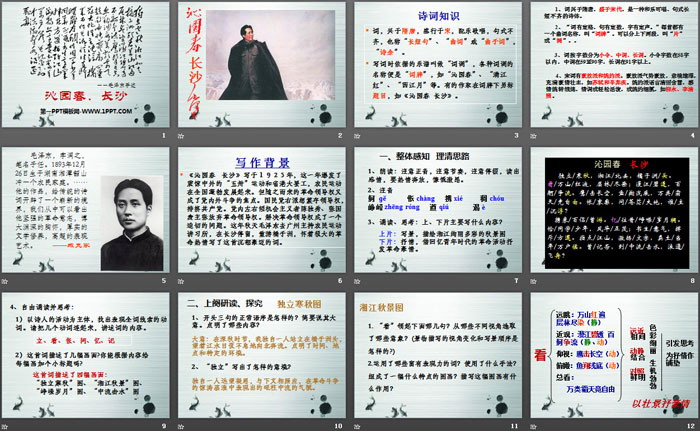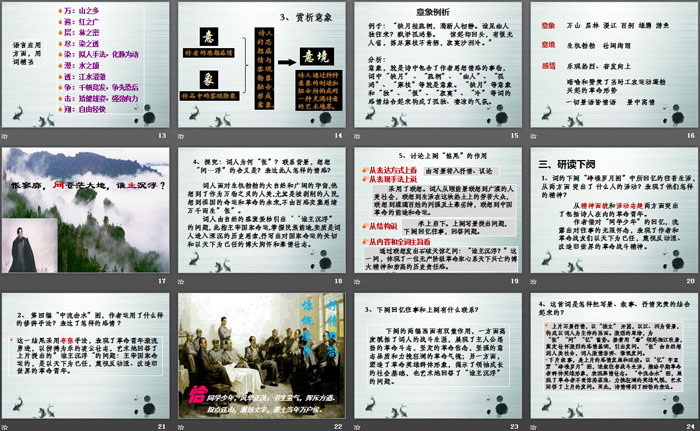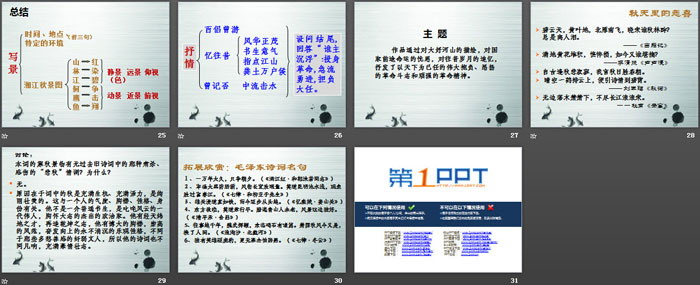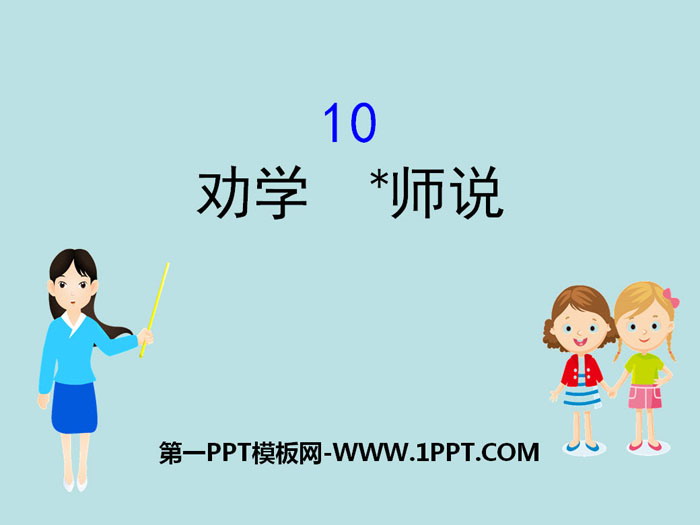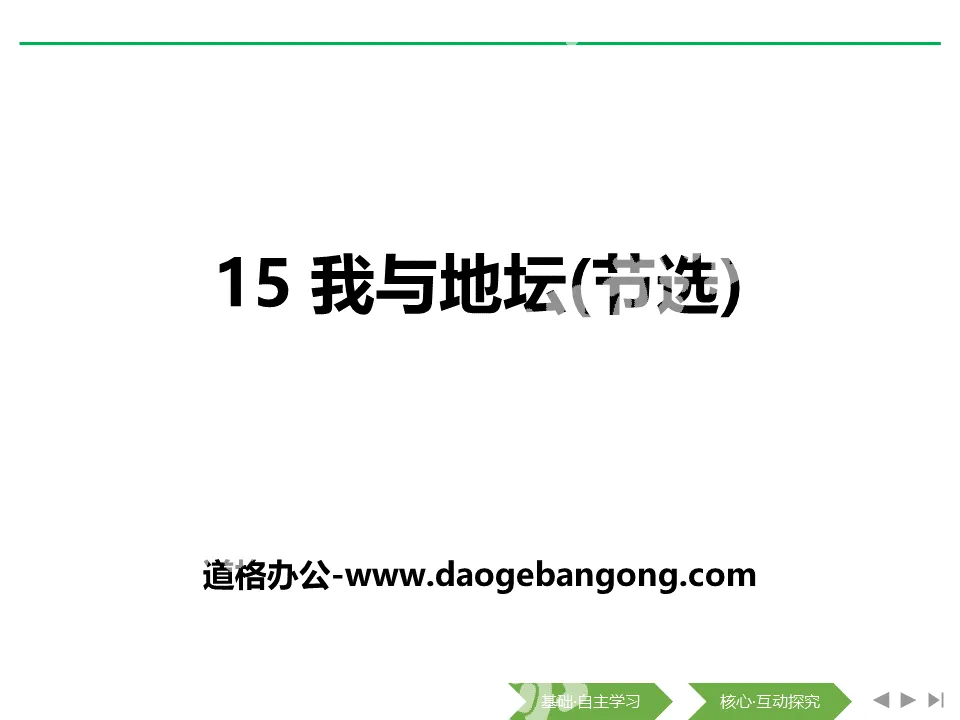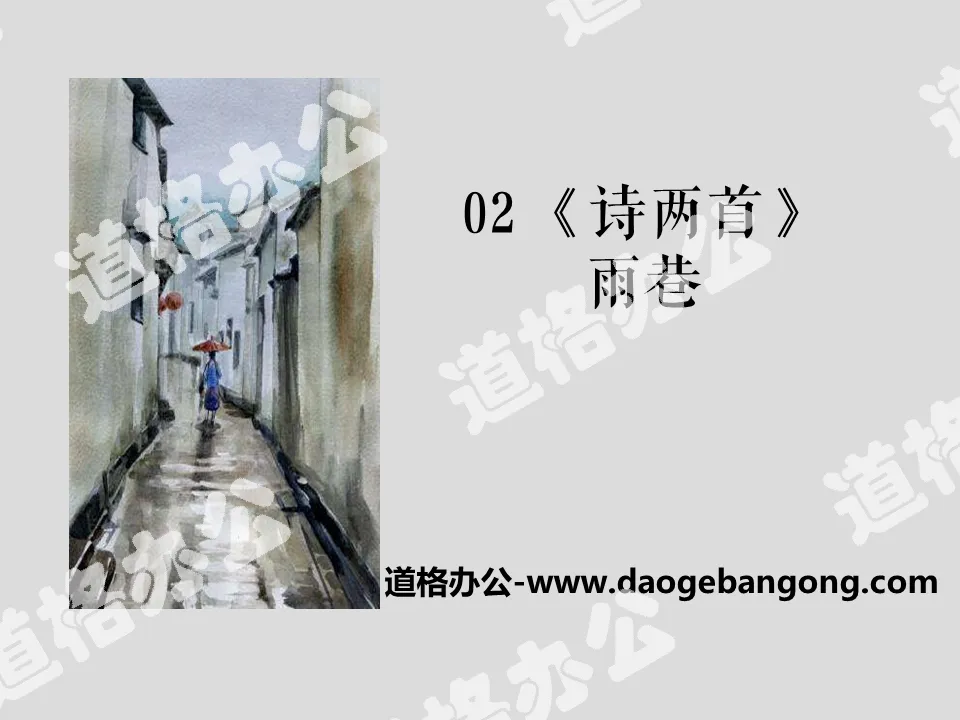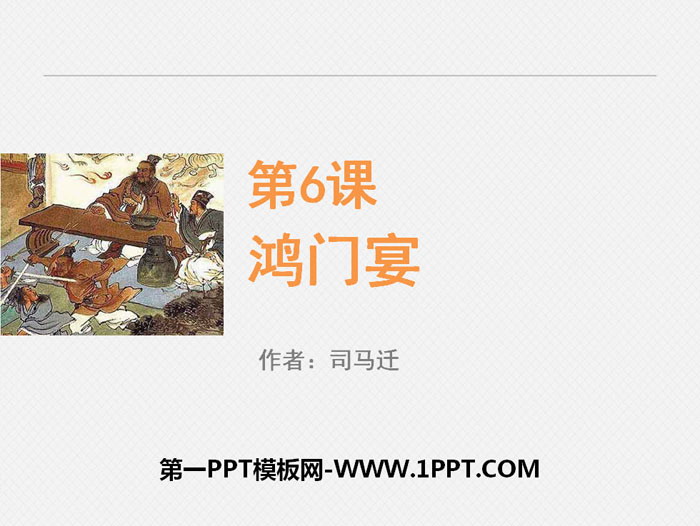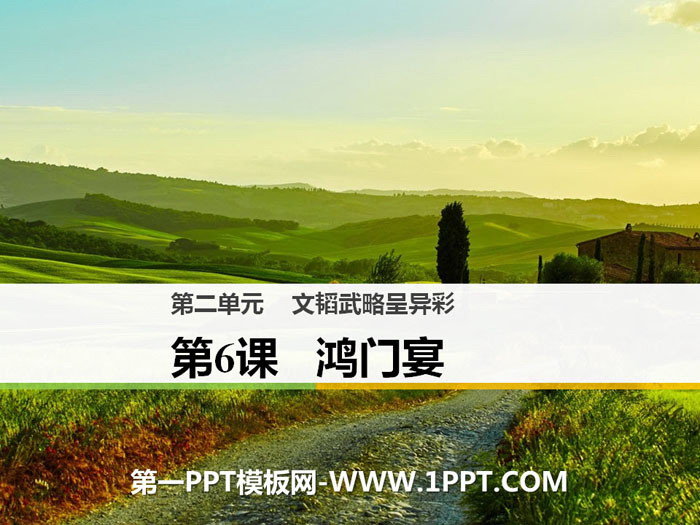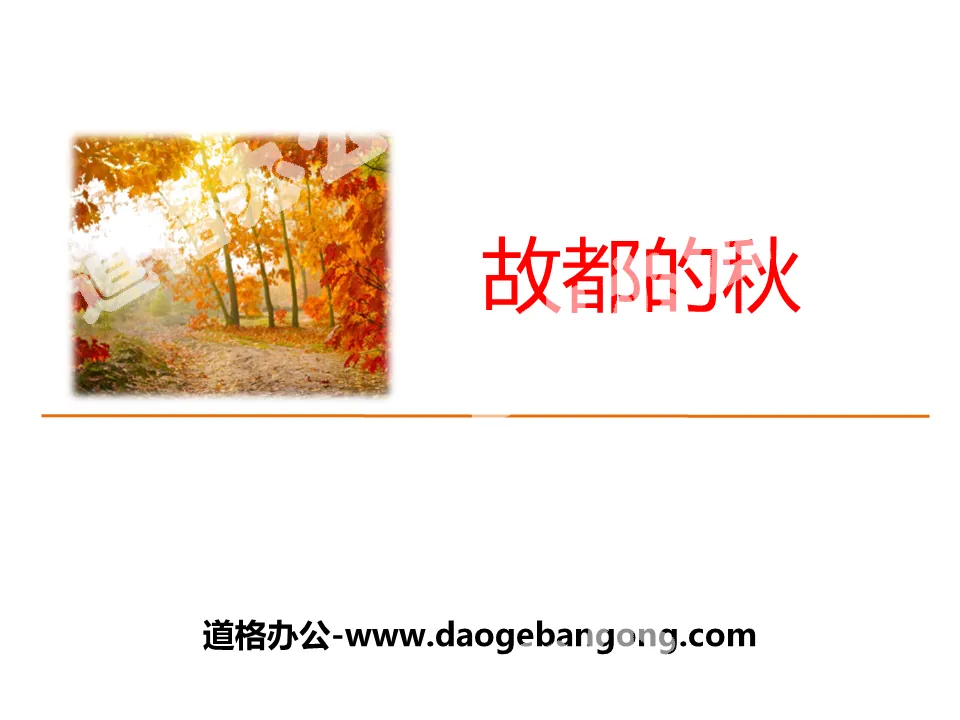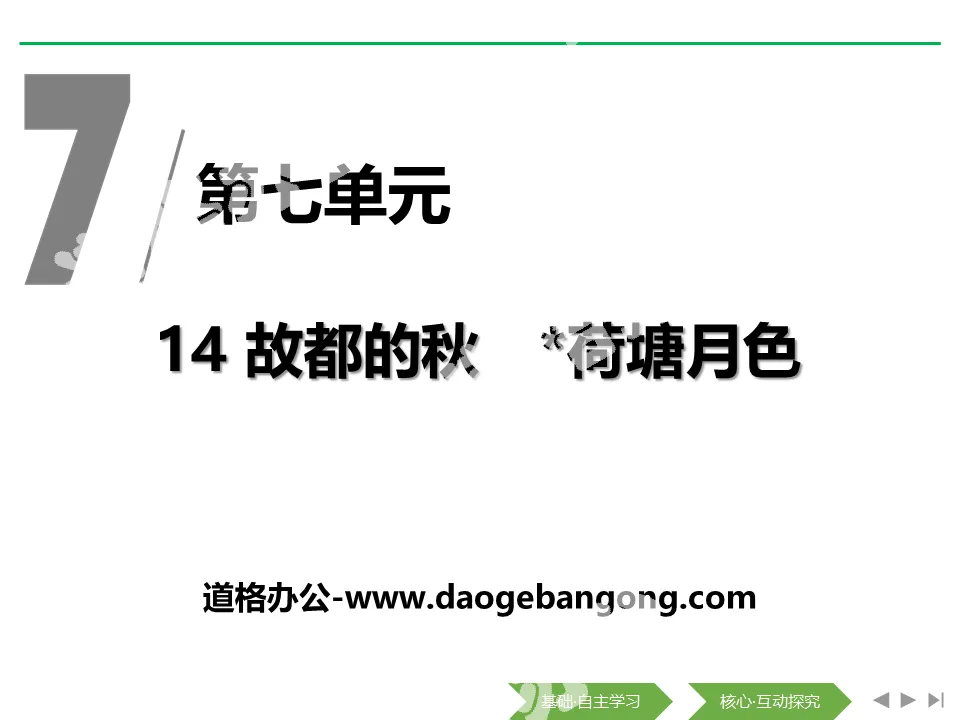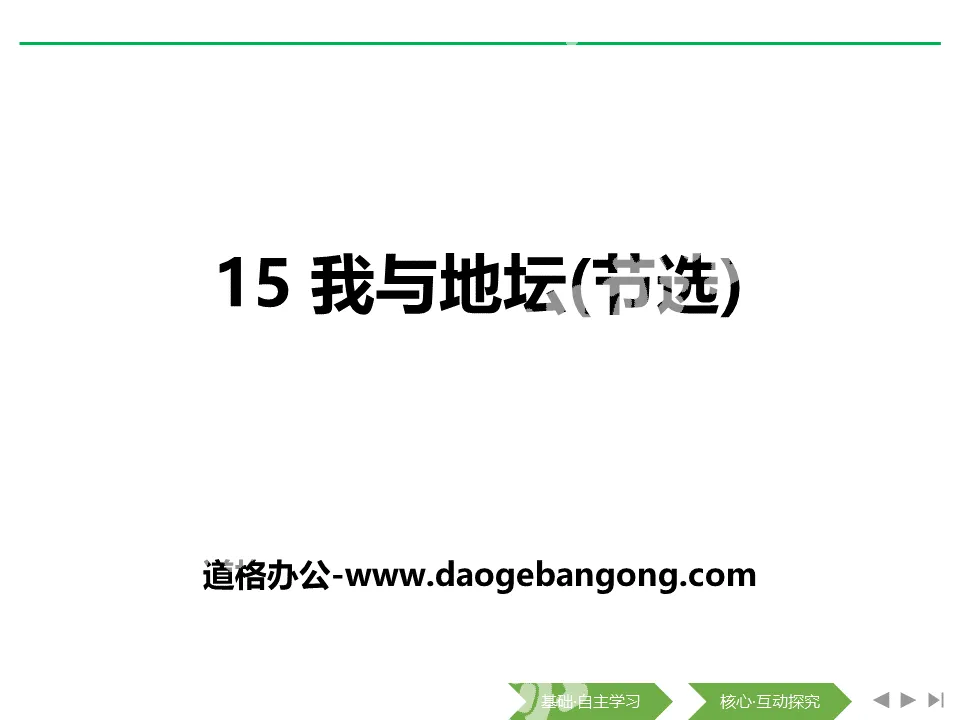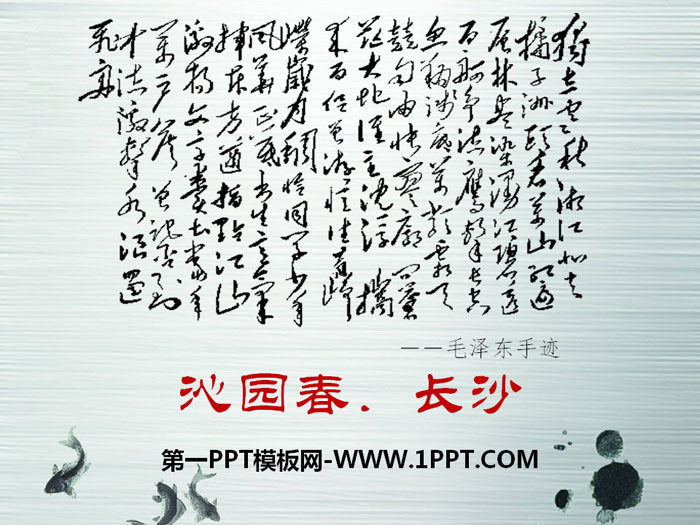
| Category | Format | Size |
|---|---|---|
| People's Education Press High School Chinese Compulsory Course 1 | pptx | 6 MB |
Description
"Qinyuanchun·Changsha" PPT courseware
Part One Content: Poetry Knowledge
Ci, which emerged in the Sui and Tang Dynasties and became popular in the Song Dynasty, is accompanied by singing and singing with uneven sentence patterns. It is also called "long and short sentences", "qu ci" or "qu ci", and "poetry".
The music score based on when writing lyrics is called "Ci Tune", and the names of various lyrics are "Ci Pai", such as "Qin Yuan Chun", "Man Jiang Hong", "Xi Jiang Yue", etc. Some writers put another title under the word card, such as "Qinyuanchun Changsha".
1. Ci flourished in the Sui and Tang Dynasties and flourished in the Song Dynasty. It is a harmonious and singable poetry style with sentences of varying lengths.
2. "Ci has a definite pattern, a sentence has a definite number, and a word has a definite tone." Each song has a name for the lyrics, which is called "Cipai". It can be divided into two sections, called "piece" or "que". .
3. Words are divided into small order, middle tone and long tone according to the number of characters. The number of characters for a small order should be within 58, for a middle tune, between 59 and 90, and for a long tune, more than 91 characters.
4. There are two types of Song poetry: bold and graceful. The Bold and Unconstrained School has a bold and bold style, a powerful artistic conception, and is full of heroic ambitions, such as Su Shi and Xin Qiji. The language of the graceful school is clear and subtle, and the emotions are gentle and lingering. The mood may be light and lively, or graceful and delicate, such as Liu Yong and Li Qingzhao.
Qin Yuanchun Changsha PPT, the second part: writing background
"Qinyuanchun Changsha" was written in 1925. In this year, the May 30th Movement and the provincial and Hong Kong strikes broke out, which shocked China and foreign countries. The peasant movement flourished across the country. However, the subsequent revolutionary leadership became the focus of struggle within and outside the party. The right wing of the Kuomintang wants to usurp leadership and squeeze out the Communist Party. Chen Duxiu and Zhang Guotao, left-right opportunists within the party, advocated giving up revolutionary leadership. Solving the problem of revolutionary leadership became an urgent problem. In the autumn of this year, Mao Zedong went to Guangzhou to host a peasant movement workshop, stopped in Changsha, revisited Juzizhou, and wrote this melancholy and heroic poem with great revolutionary enthusiasm.
Qinyuanchun Changsha PPT, the third part: overall perception and clarifying ideas
1. Read aloud: pay attention to the correct pronunciation, pay attention to the rhythm, pay attention to the pauses, read out the feelings, be enthusiastic and impassioned.
2. Phonetic notation
Ge, regret, carry thick
majestic, majestic
3. Read and think: What are the main contents of the first and second parts?
The first film: Scenery, depicting the colorful autumn scenery of the Xiangjiang River
Next film: Lyrical, expressing revolutionary pride by recalling the revolutionary activities of his youth.
4. Read and think freely:
1) Using the poet’s activities as the main subject, find the verbs that express clues to the whole word. Please connect several verbs to tell the content of the words.
Stand, look, feel sad, ask, recall, remember
2) How many pictures does this poem describe? Can you add a subtitle to each picture based on its content?
This poem describes four scenes:
"Independent Cold Autumn" picture, "Xiangjiang Autumn Scenery" picture,
The picture of "Troublesome Years" and the Picture of "Strike in the Water"
Qinyuanchun Changsha PPT, the fourth part: reading and exploring
Independent winter autumn picture
1. What is the normal word order of the first three sentences? Briefly describe its main idea. What content was highlighted?
General idea: In late autumn, I stood alone at the head of Orange Island, watching the river rushing north day and night. Point out time, place and specific circumstances.
2. What kind of artistic conception does "independence" convey?
Looking and meditating alone in the distance, echoing the following, showing the spirit of a pillar in the stormy waves of the revolutionary struggle.
Xiangjiang River Autumn Scenery
1. Which of the following sentences does "look" lead to? What images were selected from what different perspectives? (What are the changes in perspective and the order of describing scenes?)
2. What expressive words are used? What techniques were used? What characteristics does it form a picture? What is the purpose of describing this picture?
Imagery Examples
Example: "The missing moon hangs on the sparse tung trees, which breaks the silence of the people. Who can see lonely people coming and going alone? Misty and lonely shadows. I wake up but look back. I hate that no one cares about me. I pick up all the cold branches and refuse to live on it. The lonely sandbank is cold. "
Analysis: Imagery is the things in the poem that contain the author's thoughts and emotions. The words "missing moon", "sparse tung trees", "youren", "lonely Hong", "cold branches", etc. are the images. The combination of images such as "missing moon" and words such as "aloneness", "hate", "loneliness" and "cold" creates a lonely and desolate atmosphere.
Qin Yuanchun Changsha PPT, Part 5: Study the next section
1. The past life recalled in the "Picture of the Glorious Years" at the bottom of the poem highlights who's activities from two aspects? What kind of spirit did they express?
The revolutionary youth, including poets, are highlighted in terms of their spiritual outlook and activity interests.
The author uses the memories of his "classmates" to reveal his infinite nostalgia for the past, expressing the revolutionary fighting spirit of the author and his revolutionary comrades who take the world as their own responsibility, despise the reactionaries, and transform the old world.
2. In the fourth picture of "Strike in the Water", what kind of rhetorical technique does the author use? What feelings are expressed?
This ending uses an exaggerated technique to show the revolutionary young people's ambition to advance bravely and take pleasure in hard work. It artistically answers the question of "who is in charge of the ups and downs" raised in the previous film: The one who controls the destiny of the country is the one who takes the world as his own responsibility. , a revolutionary youth who despises reactionaries and transforms the old world.
3. What is the connection between going down to remember the past and going up to the place?
The two pictures at the bottom of the column have a dual function. On the one hand, they highly summarize the poet's fighting career, showing the protagonist's high-spirited revolutionary fighting spirit, firm revolutionary belief, strong will and quality, and revolutionary courage to turn the tide; on the other hand, they create a The group image of revolutionary heroes reveals the social foundation for the growth of leaders, and artistically answers the question of "who is in charge of ups and downs?"
4. How does this poem perfectly combine scene description, narrative, and lyricism?
The first film describes the scenery and is lyrical, starting with "Independence", with Jiang and Zhou as the background, forming a picture with the poet as the main body. The stirring thoughts are preparing for "sadness", "questioning" and "remembering". Then "look" is used to lead to the autumn scenery of the Xiangjiang River, setting a strong emotional tone and triggering questions. "Disappointment" comes from nature to human society, and the poet is passionate and generous in asking questions.
The narrative of the second film is the emotional development and continuation of the previous film. The word "memory" is used directly through the picture of "turbulent years" to recall the past fighting life, depict the heroic image of the early revolutionaries, and express their heroic aspirations. The picture "Strike in the Water" shows the heroic spirit of the revolutionaries who are not afraid of the stormy waves and turn the tide. Art answers the question of the previous film. At this point, the poetry has been expressed heartily.
Qinyuanchun Changsha PPT, Part Six: Theme
By describing the great rivers and mountains, worrying about the future and destiny of the country, and recalling the past years, the work expresses the great ambition of taking the world as its own responsibility, the high revolutionary fighting spirit and the indomitable revolutionary spirit.
The joys and sorrows of autumn
The sky is blue, the leaves are yellow on the ground, the wild geese flying from the north to the south, who is drunk in the autumn forest at dawn? Always left in tears. ——"The Romance of the West Chamber"
The yellow flowers are piled up all over the ground, and they are haggard and damaged. Who is worthy of picking them now? ——Li Qingzhao's "Slow Voice"
Since ancient times, autumn has been a sad and lonely time. I say that autumn is better than spring.
A crane flies above the clouds in a clear sky, bringing poetry to the blue sky. ——Liu Yuxi's "Autumn Poems"
The endless falling trees rustled, and the endless Yangtze River rolled in. ——Du Fu's "Ascend the High"
Discussion: Does the cold autumn scenery in this poem have the kind of solemn and sentimental "sad autumn" mood found in old poems in the past? Why?
none.
The reason is that autumn in the poem is full of vitality, vitality, and gorgeous. This is related to a person's magnanimity, mind, character, and identity. He is not an ordinary scholar, but a great man of the all-powerful generation and an outstanding politician with great ambitions. He has great talent and ambition to rebuild the world. He has a broad mind, a lofty demeanor, and an optimistic character that never gets depressed. He is different from those sentimental and delicate literati, so his poems are also extraordinary and full of heroic ambition. .
Keywords: Free download of PPT courseware for high school Chinese compulsory course 1 of People's Education Press, Qinyuanchun Changsha PPT download, .PPT format;
For more information about the "Qinyuanchun Changsha" PPT courseware, please click the "Qinyuanchun Changsha" ppt tag.
"Qinyuanchun·Changsha" PPT high-quality courseware download:
"Qinyuanchun Changsha" PPT high-quality courseware download Part 1: Reading some cultural knowledge (1) Ci Ci is a different style of poetry, which originated in the Sui and Tang Dynasties and became popular in the Song Dynasty. It is also called Shiyu, long and short sentences, Yuefu, Ququ Ci, etc. The characteristics of the word are that the word has a definite tone, the tone has a definite sentence, and the sentence...
"Qinyuanchun·Changsha" PPT quality courseware:
The first part of the PPT courseware "Qinyuanchun Changsha": [Reading Expo] 1. Mao Zedong, a politician with charming writer and poet feelings Mao Zedong (18931976), Marxist, great proletarian revolutionist, strategist and theorist, China Communist Party, China...
"Qinyuanchun·Changsha" PPT quality courseware:
"Qinyuanchun Changsha" PPT high-quality courseware Part 1: 1. Know the author Mao Zedong, the great poet who led a generation of coquettish people ① Mao Zedong, whose courtesy name is Runzhi and whose pen name is Ziren. Born on December 26, 1893 in a peasant family in Shaoshanchong, Xiangtan, Hunan Province, on September 9, 1976 in...
File Info
Update Time: 2024-07-02
This template belongs to Chinese courseware People's Education Press High School Chinese Compulsory Course 1 industry PPT template
"Qinyuanchun·Changsha" PPT courseware Simple campus recruitment activity planning plan summary enterprise and institution recruitment publicity lecture PPT template is a general PPT template for business post competition provided by the manuscript PPT, simple campus recruitment activity planning plan summary enterprise and institution recruitment promotion Lecture PPT template, you can edit and modify the text and pictures in the source file by downloading the source file. If you want more exquisite business PPT templates, you can come to grid resource. Doug resource PPT, massive PPT template slide material download, we only make high-quality PPT templates!
Tips: If you open the template and feel that it is not suitable for all your needs, you can search for related content "Qinyuanchun·Changsha" PPT courseware is enough.
How to use the Windows system template
Directly decompress the file and use it with office or wps
How to use the Mac system template
Directly decompress the file and use it Office or wps can be used
Related reading
For more detailed PPT-related tutorials and font tutorials, you can view: Click to see
How to create a high-quality technological sense PPT? 4 ways to share the bottom of the box
Notice
Do not download in WeChat, Zhihu, QQ, built-in browsers, please use mobile browsers to download! If you are a mobile phone user, please download it on your computer!
1. The manuscript PPT is only for study and reference, please delete it 24 hours after downloading.
2. If the resource involves your legitimate rights and interests, delete it immediately.
3. Contact information: service@daogebangong.com
"Qinyuanchun·Changsha" PPT courseware, due to usage restrictions, it is only for personal study and reference use. For commercial use, please go to the relevant official website for authorization.
(Personal non-commercial use refers to the use of this font to complete the display of personal works, including but not limited to the design of personal papers, resumes, etc.)
Preview

